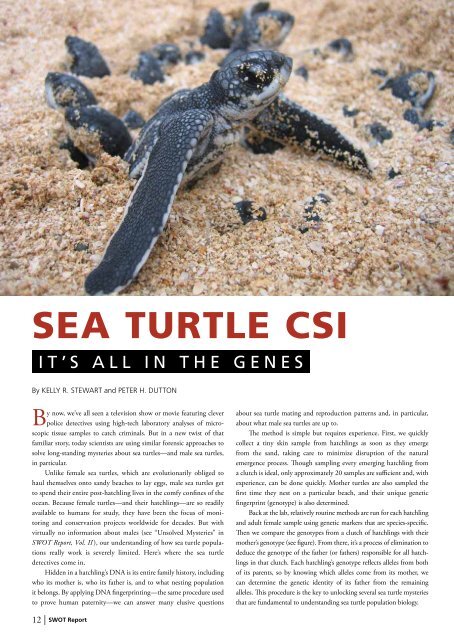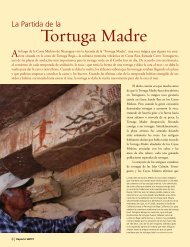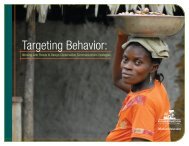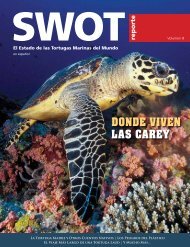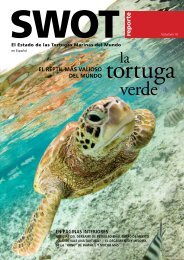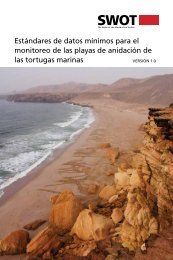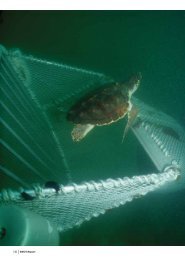Sea TurTle CSI
Sea TurTle CSI
Sea TurTle CSI
You also want an ePaper? Increase the reach of your titles
YUMPU automatically turns print PDFs into web optimized ePapers that Google loves.
<strong>Sea</strong> Turtle <strong>CSI</strong><br />
I t ’ s a l l i n t h e G e n e s<br />
By Kelly R. Stewart and Peter H. Dutton<br />
By now, we’ve all seen a television show or movie featuring clever<br />
police detectives using high-tech laboratory analyses of microscopic<br />
tissue samples to catch criminals. But in a new twist of that<br />
familiar story, today scientists are using similar forensic approaches to<br />
solve long-standing mysteries about sea turtles—and male sea turtles,<br />
in particular.<br />
Unlike female sea turtles, which are evolutionarily obliged to<br />
haul themselves onto sandy beaches to lay eggs, male sea turtles get<br />
to spend their entire post-hatchling lives in the comfy confines of the<br />
ocean. Because female turtles—and their hatchlings—are so readily<br />
available to humans for study, they have been the focus of monitoring<br />
and conservation projects worldwide for decades. But with<br />
virtually no information about males (see “Unsolved Mysteries” in<br />
SWOT Report, Vol. II ), our understanding of how sea turtle populations<br />
really work is severely limited. Here’s where the sea turtle<br />
detectives come in.<br />
Hidden in a hatchling’s DNA is its entire family history, including<br />
who its mother is, who its father is, and to what nesting population<br />
it belongs. By applying DNA fingerprinting—the same procedure used<br />
to prove human paternity—we can answer many elusive questions<br />
about sea turtle mating and reproduction patterns and, in particular,<br />
about what male sea turtles are up to.<br />
The method is simple but requires experience. First, we quickly<br />
collect a tiny skin sample from hatchlings as soon as they emerge<br />
from the sand, taking care to minimize disruption of the natural<br />
emergence process. Though sampling every emerging hatchling from<br />
a clutch is ideal, only approximately 20 samples are sufficient and, with<br />
experience, can be done quickly. Mother turtles are also sampled the<br />
first time they nest on a particular beach, and their unique genetic<br />
fingerprint (genotype) is also determined.<br />
Back at the lab, relatively routine methods are run for each hatchling<br />
and adult female sample using genetic markers that are species-specific.<br />
Then we compare the genotypes from a clutch of hatchlings with their<br />
mother’s genotype (see figure). From there, it’s a process of elimination to<br />
deduce the genotype of the father (or fathers) responsible for all hatchlings<br />
in that clutch. Each hatchling’s genotype reflects alleles from both<br />
of its parents, so by knowing which alleles come from its mother, we<br />
can determine the genetic identity of its father from the remaining<br />
alleles. This procedure is the key to unlocking several sea turtle mysteries<br />
that are fundamental to understanding sea turtle population biology.<br />
12 | SWOT Report
Mystery #1: Age to maturity<br />
Population recovery goals are based on how long turtles take to reach<br />
maturity, making this factor among the most fundamental for conservation.<br />
With this factor in mind, we have been sampling leatherback<br />
hatchlings for three years (17,087 hatchlings sampled to date) at Sandy<br />
Point National Wildlife Refuge, St. Croix, U.S. Virgin Islands. Each<br />
year, the hatchling fingerprints are compared to those of new nesting<br />
females. Eventually, we hope to match a turtle that left the nesting<br />
beach in a known year with a first-time nester. This information would<br />
give us direct evidence of the age to maturity, at least for a leatherback<br />
on that beach.<br />
Mystery #2: Paternity patterns and<br />
male identity<br />
DNA fingerprinting also allows us to deduce mating patterns, such as<br />
multiple paternity, in sea turtles. Once we have identified genotypes of<br />
the hatchlings and mothers, we can deduce the paternal genotypes—<br />
from one to many fathers per clutch—and can identify individual<br />
males that are actively breeding in the population (see figure). This<br />
procedure means that we can sample males in the population from<br />
the nesting beach without ever having seen them or sampled them in<br />
the field. In 2009 at Sandy Point, we examined 38 clutches from 12<br />
females and found that 17 different males were responsible for those<br />
nests; 5 of the 12 females had each mated with 2 different males.<br />
MOTHER’S GENETIC PROFILE<br />
Mystery #3: Ratio of males to females<br />
Until now, we have been able to count only females (on nesting<br />
beaches), while males remain out of reach. In 2010, we assessed hatchlings<br />
belonging to 46 nesting females at Sandy Point and found that<br />
47 different males had mated with those females. One male had mated<br />
with three different females, and several others had mated with two<br />
females. Some researchers have hypothesized that there is a shortage of<br />
males and that sex ratios might be too highly skewed toward females<br />
for populations to remain viable in the future, especially considering<br />
the warming impacts of climate change and the feminization of sea<br />
turtle populations that is speculated to occur as a result. However, our<br />
results show that this is clearly not the case, at least at Sandy Point,<br />
where plenty of males are actively breeding in the population; breeding<br />
males may actually outnumber breeding females in a given year. In fact,<br />
we identified one male that had been actively breeding in both 2009<br />
and 2010 (with different females).<br />
A<br />
HATCHLING 1’S GENETIC PROFILE<br />
HATCHLING 2’S GENETIC PROFILE<br />
B<br />
B<br />
C<br />
Mystery #4: Male reproductive success<br />
Paternity analysis allows us to assess the individual reproductive success<br />
of males in addition to that of females on nesting beaches. Once we<br />
identify individual males through the hatchlings they have sired, we<br />
can track the success of those individual fathers. For each male, we can<br />
investigate how many hatchlings he produced, how many females he<br />
mated with, and how many years he has been reproductively active.<br />
Unlike beach-going female sea turtles, males are usually beyond<br />
the reach of our research, so we have to apply some ingenuity to reveal<br />
their secrets. Genetic analysis is a practical but powerful approach to<br />
fill voids in our understanding of sea turtle biology and to improve<br />
how we assess sea turtle populations. And we think it would make a<br />
pretty compelling television show too. •<br />
A<br />
At each locus in the DNA of every individual are two alleles—one inherited from<br />
the mother and one from the father. The mother turtle’s genetic profile (top panel)<br />
and genotypes for two hatchlings (middle and bottom panels) are shown above.<br />
Once we account for the maternal alleles (A and B) in the hatchlings’ genetic<br />
profiles, the remaining alleles (C and D) must belong to the father turtle. This<br />
method allows us to identify the hatchlings’ father without having to sample him<br />
directly. ABOVE: A researcher organizes DNA samples collected on the beach in<br />
St. Croix, U.S. Virgin Islands. © Jeremy W. Smith AT LEFT: A leatherback hatchling<br />
emerges from the sand on St. Croix, U.S. Virgin Islands. Scientists analyzed DNA<br />
from more than 17,000 hatchlings to answer important questions about population<br />
demography and life history. © Kelly Stewart<br />
D<br />
<strong>Sea</strong>TurtleStatus.org | 13


